In this Article:
- External Surface Landmarks
- Soft Tissue of the External Nose
- Bone & Cartilage of the Nose
- Blood Supply to the Nose
- Nerve Sensation to the Nose
- Internal Nasal Anatomy
- References
The following illustration is a simplified summary for the clinical anatomy of the nose.
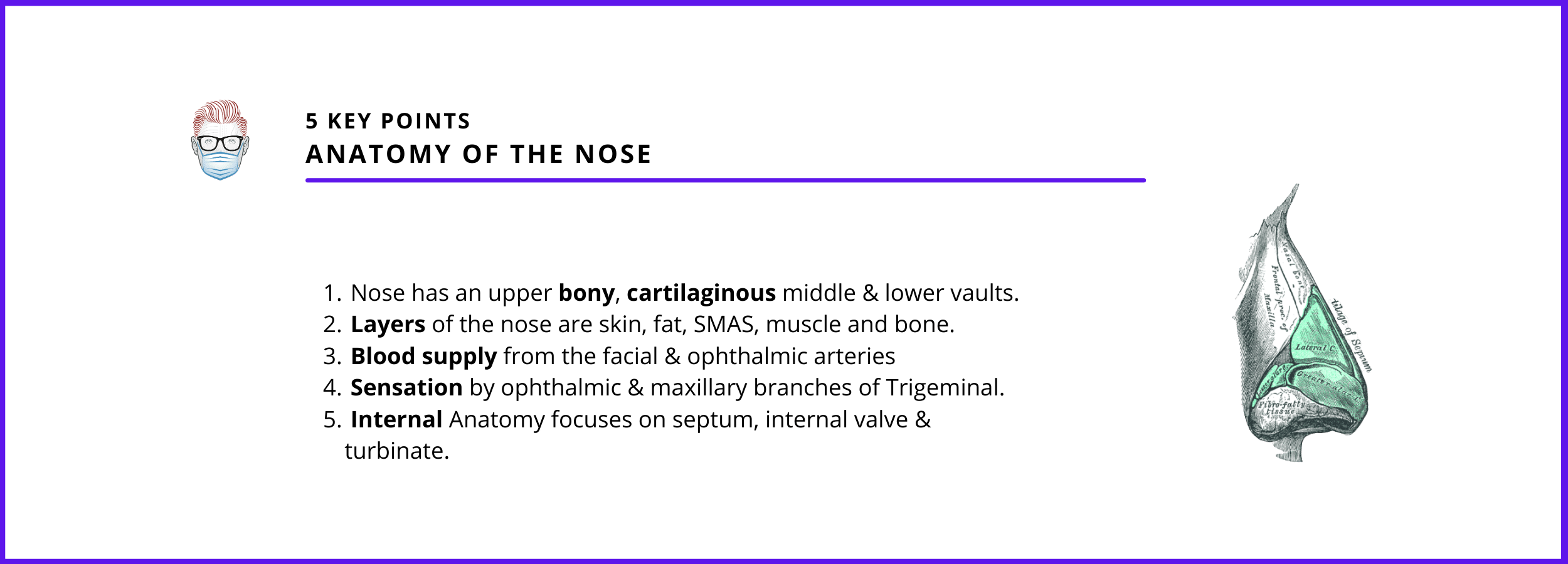
Now that you have a brief overview of what to expect in this article, it's time to dive deep into the relevant areas of nose anatomy.
External Surface Landmarks
The nose is commonly divided into 3 areas: the upper, middle and lower thirds. These 3 areas can be corrrelated clinicially to the surface landmarks of nasion, rhinion and tip, respectively.
The important external surface anatomy of the nose is seen below.
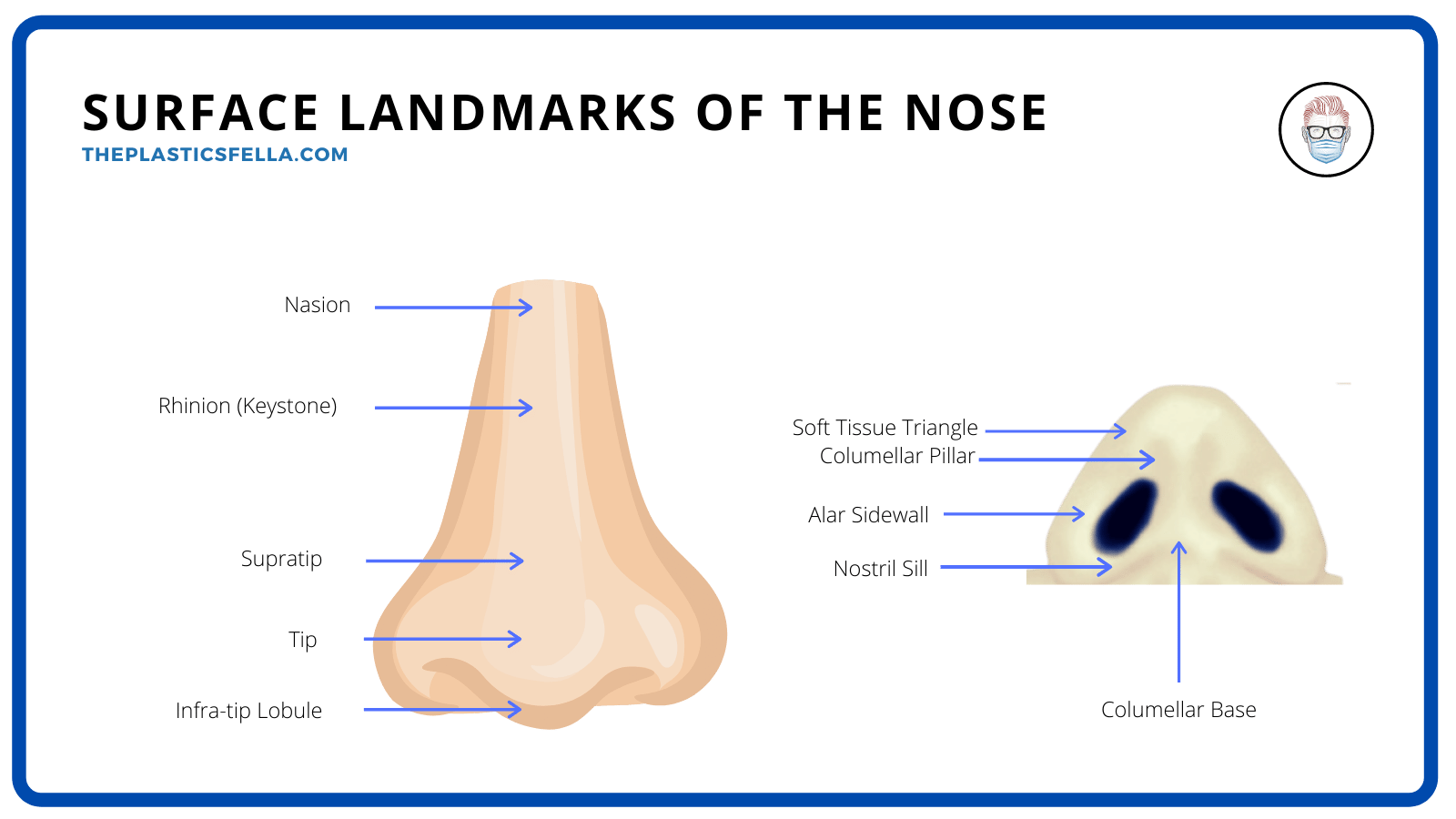
These landmarks are commonly assess in both clinical and examination settings.
Soft Tissue of the External Nose
The soft tissue anatomy of the nose can be simplied into 4 layers: skin, fat, fascia and muscle.
Skin & Fat
- Upper 2/3 is thin (Lessard et al, 1985).
- Lower 1/3 is less mobile, more sebaceous (O'Neal et al 1999).
- In some areas, there is a supeficial fatty and deep fatty layer.
Fascia
- Fascia surrounding the nose is a fibromuscular layer
- This includes nasal subcutaneous muscular aponeurotic system (SMAS).
Muscles
- 4 groups of nose muscles, as detailed below in the table (Griesman et al 1944)
- Innervated by zygomaticotemporal division of the facial nerve.
- Levator Labii Superioris Alaeque Nasi keeps the external nasal valve open. This may be paralyzed in patients with a facial nerve palsy.
- Depressor septi can be divided in a rhinoplasty to decrease tip projection.
- Nasalis assists in nasal airway patency.
Bone & Cartilage of the Nose
The nasal cavity is an osseocartilaginous framework divided into 3 main vaults. The upper 1/3 is bone, the middle and lower thirds are cartilage. These divisions overlap at the keystone and scroll area, respectively.
Upper 1/3 - Bony Vault
The “Bony Vault” is a pair nasal bones surrounded by frontal, maxillary and ethmoid bones. It has a characteristic hour-glass figure and is generally thicker and more dense above the medial canthus.
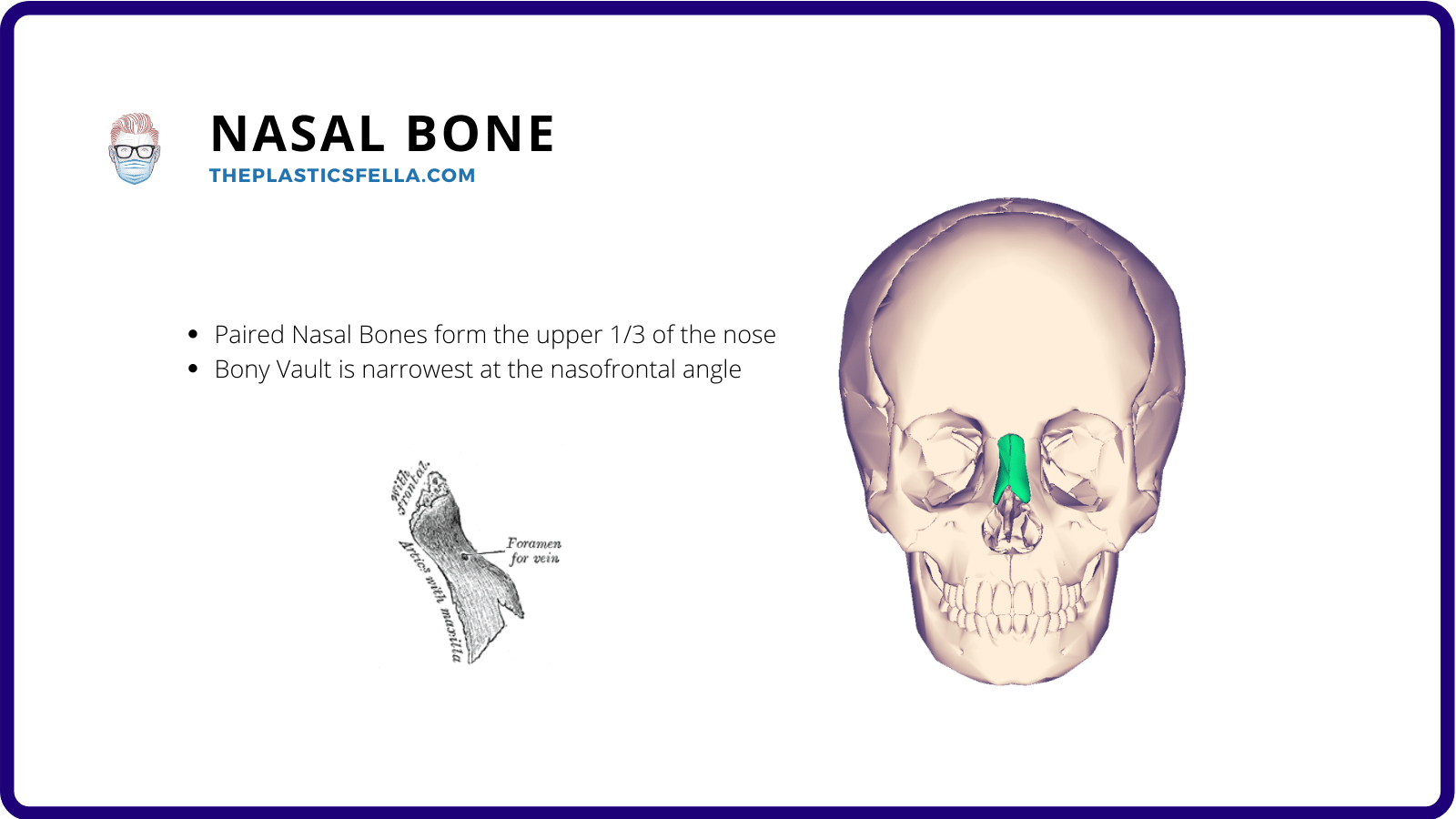
In relation to adjacent bones, the nasal bone interdigitates with:
- Superior: Nasal process of the frontal bone
- Lateral: Frontal process of the maxilla
- Posterior: Perpendicular plate of the ethmoid
- Medial: Paired Nasal bone
Middle 1/3 - Cartilaginous Vault
The middle 1/3 of the nasal cavity is a cartilaginous structure of:
- Paired Upper lateral cartilages (ULCs) creates an internal nasal valve at the ULC’s caudal edge and nasal septum. This is the narrowest part of the nasal airway
- Dorsal septum
- Soft tissue attachments.
It overlaps with the upper bony 1/3 at the keystone area, which is often the widest part of the dorsum.
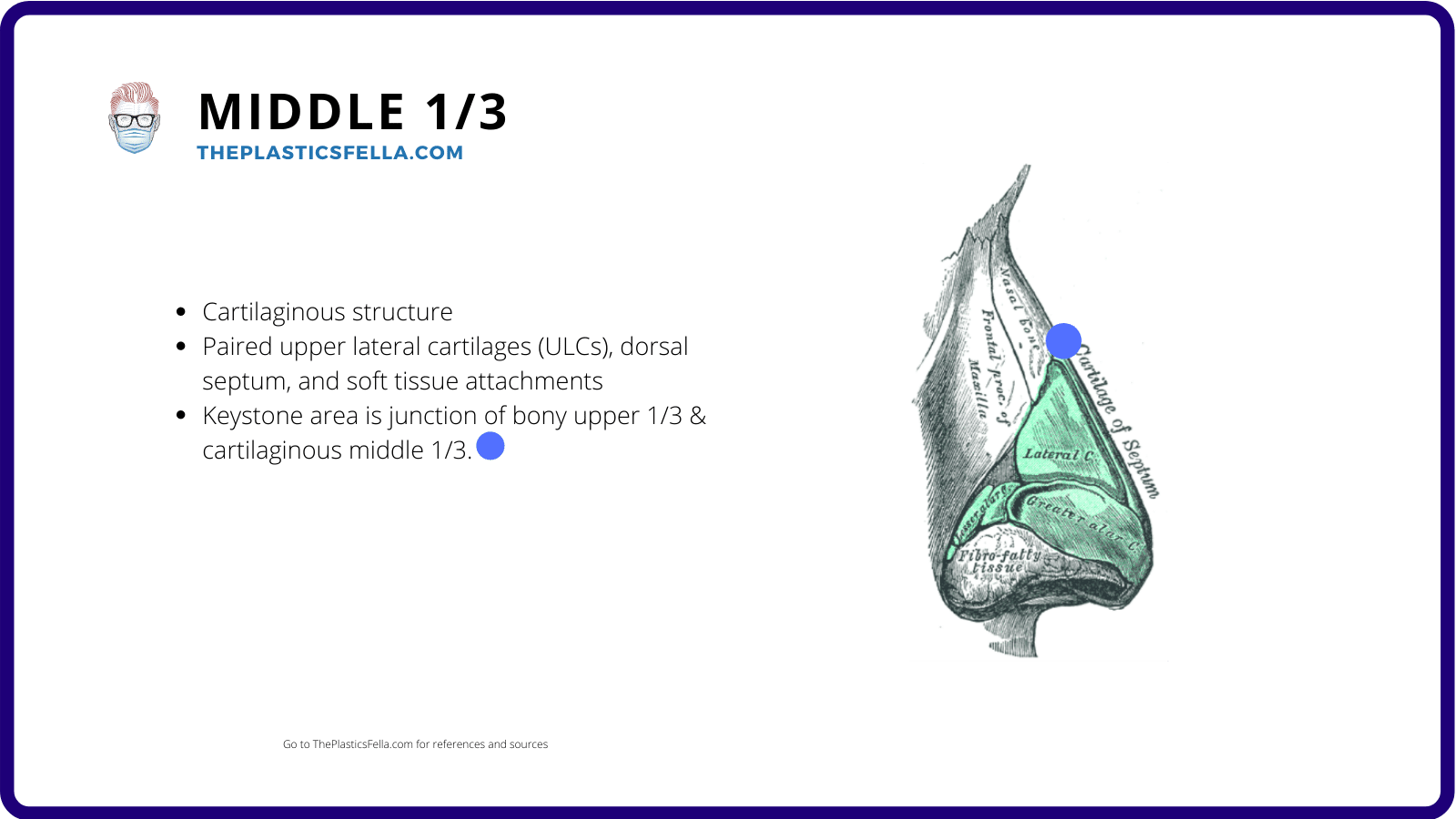
The membranous section connects the cartilaginous septum to the medial crura of the alar cartilages. This is important when performing a transfixion incision.
Lower 1/3 - Cartilaginous Vault
The lower vault is a cartilaginous structure composed of paired lower lateral cartilages (LLC), which strongly influences tip projection, rotation, and definition. The junction between the ULC and LLCs is called the scroll area.
It can be divided into 3 crus:
- Medial: runs through the columella.
- Middle: forms the nasal tip.
- Lateral: passes superolateral from tip. Shares a common perichondrium with accessory cartilage.
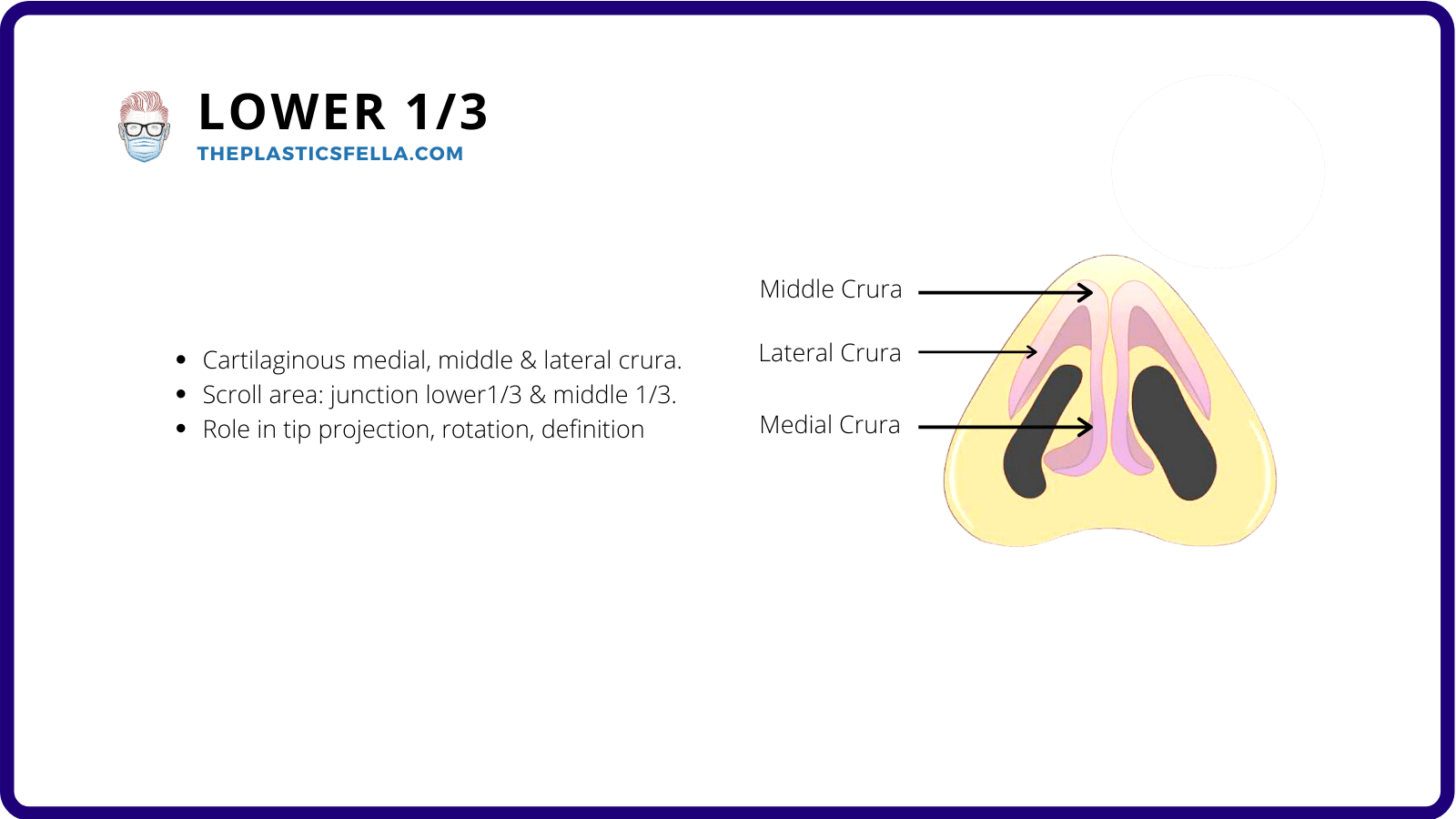
Blood Supply to the Nose
The primary blood supply of the nose is the facial and ophthalmic arteries, which travel the musculo-aponeurotic plane3 ( Letourneau et al, 1988)
Facial Artery
The facial artery provides blood supply to the nasal tip two banches:
- Columellar branches of the superior labial artery (divided in an open rhinoplasty)
- Lateral nasal branch of the angular artery.
Ophthalmic Artery
The opthalmic artery supplies the superior portion of the nasal envelope via:
- Anterior ethmoidal artery.
- Dorsal nasal artery.
- External nasal artery.
Nerve Sensation to the Nose
External nasal skin is supplied by ophthalmic (V1) & maxillary (V2) branches of trigeminal (CN V) nerve.
Branches of the Ophthalmic Nerve
- Infratrochlear and supratrochlear nerves supply radix and cranial part of dorsum.
- External nasal branch of the anterior ethmoidal nerve supplies the caudal part of the dorsum and tip. This emerges between the nasal bones and upper lateral cartilages (keystone area)
Branches of Maxillary Nerve
- Infraorbital nerve supplies lateral nose and tip.
- The nasal branch from the anterior superior alveolar nerve supplies the columella.
- The external nasal branch of the anterior ethmoid innervates middle vault and nasal tip.
Internal Nasal Anatomy
Important internal structures include the nasal septum, internal nasal valve and turbinates.
Nasal Septum
The nasal septum is a cartilaginous (cranial) and membranous (caudal) structure.
The cartilaginous structure is composed of:
- Anterior: quadrangular cartilage.
- Superior: Perpendicular plate of ethmoid.
- Inferior: Vomer, Nasal process of maxilla, perpendicular plate of palatine bone.
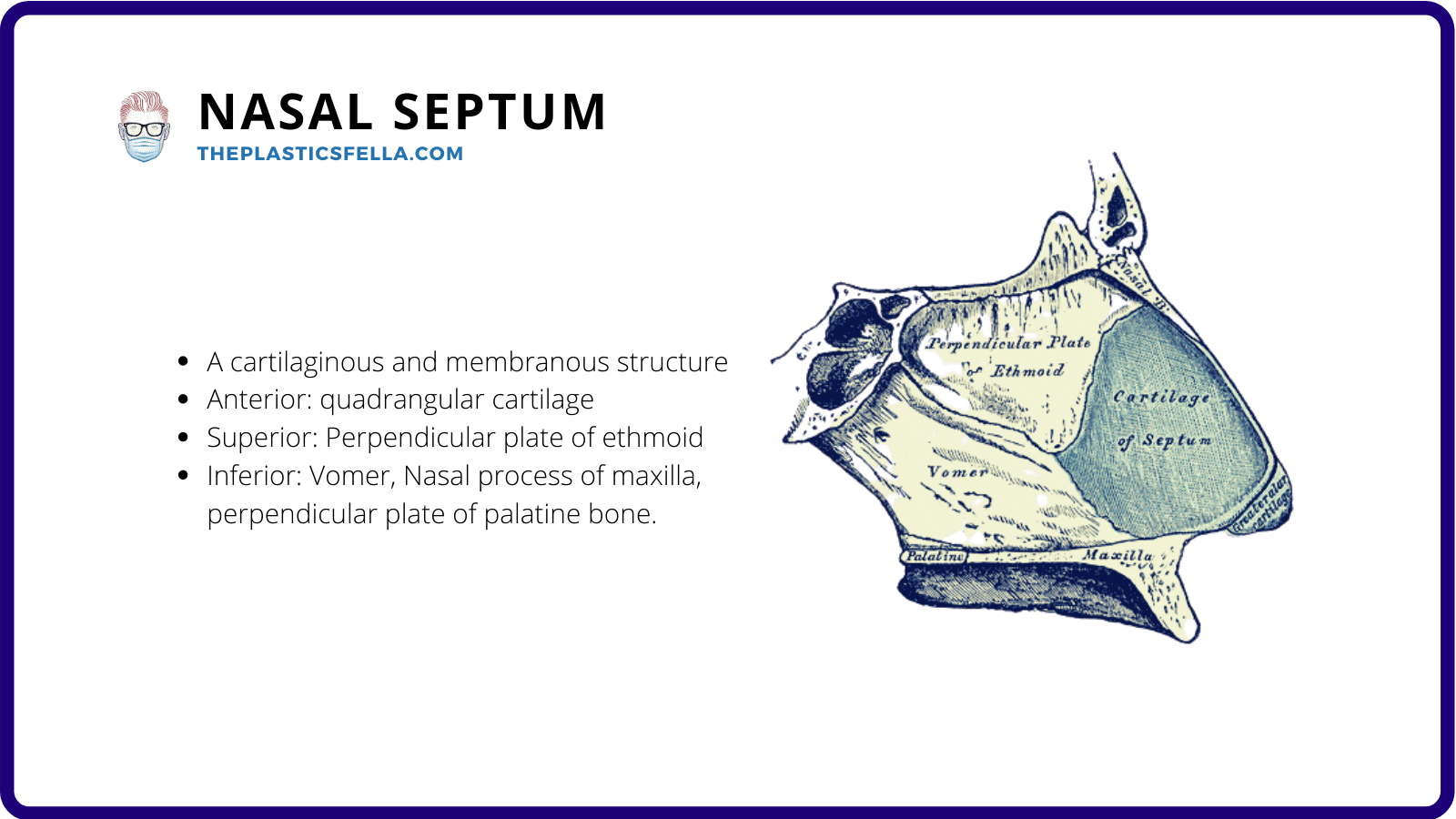
Internal Nasal Valve
The internal nasal valve has a major role in regulating airflow resistance. It is created by the junction of the ULC and nasal septum and has a normal angle of 10-15 degrees.
Prior to rhinoplasty, Cottle’s Manoeuvre is performed – cheek is pulled laterally to displace the lateral nasal wall to identify internal valve collapse. Intra-operatively, spreader grafts can be inserted between the ULC and nasal septum to widen the internal nasal valve.
Turbinates
Turbinates are paired bony structures which regulate and humidify inspired air. There are 3 levels of turbinates: superior, middle and inferior turbinates.
Superior and Middle Turbinates are extensions of the ethmoid bone.
Inferior turbinate has a role in rhinoplasties:
- A separate bone
- Hypertrophy may be the cause of airway resistance
- Deviated septum may cause the contralateral inferior turbinate to hypertrophy to create a balanced resistance in the nasal cavities.
- Complete removal of inferior turbinate may cause further obstruction by a mechanism defined as empty nose syndrome.
References
Lessard M-L, Daniel RK. Surgical Anatomy of Septorhinoplasty. Archives of Otolaryngology – Head and Neck Surgery. Published online January 1, 1985:25-29. doi:10.1001/archotol.1985.00800030059006
Oneal RM, Beil RJ Jr, Schlesinger J. SURGICAL ANATOMY OF THE NOSE. Otolaryngologic Clinics of North America. Published online February 1999:145-181. doi:10.1016/s0030-6665(05)70119-5
Letourneau A, Daniel R. The superficial musculoaponeurotic system of the nose. Plast Reconstr Surg. 1988;82(1):48-57. https://www.ncbi.nlm.nih.gov/pubmed/3380925
Griesman B. Muscles And Cartilages Of The Nose From The Standpoint Of A Typical Rhinoplasty. Archives of Otolaryngology – Head and Neck Surgery. Published online April 1, 1944:334-341. doi:10.1001/archotol.1944.00680010348009


